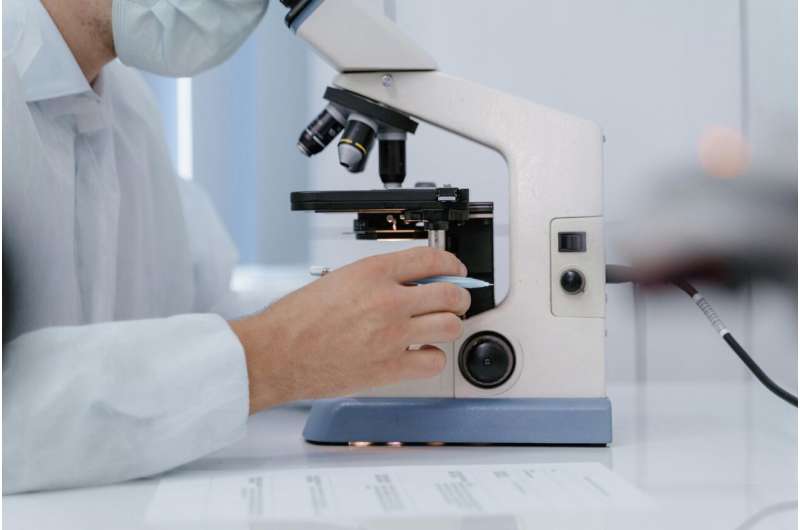
A classical way to image nanoscale structures in cells is with high-powered, expensive super-resolution microscopes. As an alternative, MIT researchers have developed a way to expand tissue before imaging it—a technique that allows them to achieve nanoscale resolution with a conventional light microscope.
In the newest version of this technique, the researchers have made it possible to expand tissue 20-fold in a single step. This simple, inexpensive method could pave the way for nearly any biology lab to perform nanoscale imaging.
“This democratizes imaging,” says Laura Kiessling, the Novartis Professor of Chemistry at MIT and a member of the Broad Institute of MIT and Harvard and MIT’s Koch Institute for Integrative Cancer Research.
“Without this method, if you want to see things with a high resolution, you have to use very expensive microscopes. What this new technique allows you to do is see things that you couldn’t normally see with standard microscopes. It drives down the cost of imaging because you can see nanoscale things without the need for a specialized facility.”
At the resolution achieved by this technique, which is around 20 nanometers, scientists can see organelles inside cells, as well as clusters of proteins.
“Twenty-fold expansion gets you into the realm that biological molecules operate in. The building blocks of life are nanoscale things: biomolecules, genes, and gene products,” says Edward Boyden, the Y. Eva Tan Professor in Neurotechnology at MIT; a professor of biological engineering, media arts and sciences, and brain and cognitive sciences; a Howard Hughes Medical Institute investigator; and a member of MIT’s McGovern Institute for Brain Research and Koch Institute for Integrative Cancer Research.
Boyden and Kiessling are the senior authors of the new study, which appears in Nature Methods. MIT graduate student Shiwei Wang and Tay Won Shin Ph.D. are the lead authors of the paper.
A single expansion
Boyden’s lab invented expansion microscopy in 2015. The technique requires embedding tissue into an absorbent polymer and breaking apart the proteins that normally hold tissue together. When water is added, the gel swells and pulls biomolecules apart from each other.
The original version of this technique, which expanded tissue about four-fold, allowed researchers to obtain images with a resolution of around 70 nanometers. In 2017, Boyden’s lab modified the process to include a second expansion step, achieving an overall 20-fold expansion. This enables even higher resolution, but the process is more complicated.
“We’ve developed several 20-fold expansion technologies in the past, but they require multiple expansion steps,” Boyden says. “If you could do that amount of expansion in a single step, that could simplify things quite a bit.”
With 20-fold expansion, researchers can get down to a resolution of about 20 nanometers, using a conventional light microscope. This allows them to see cell structures like microtubules and mitochondria, as well as clusters of proteins.
In the new study, the researchers set out to perform 20-fold expansion with only a single step. This meant that they had to find a gel that was both extremely absorbent and mechanically stable, so that it wouldn’t fall apart when expanded 20-fold.
To achieve that, they used a gel assembled from N,N-dimethylacrylamide (DMAA) and sodium acrylate. Unlike previous expansion gels that rely on adding another molecule to form crosslinks between the polymer strands, this gel forms crosslinks spontaneously and exhibits strong mechanical properties.
Such gel components previously had been used in expansion microscopy protocols, but the resulting gels could expand only about tenfold. The MIT team optimized the gel and the polymerization process to make the gel more robust, and to allow for 20-fold expansion.
To further stabilize the gel and enhance its reproducibility, the researchers removed oxygen from the polymer solution prior to gelation, which prevents side reactions that interfere with crosslinking. This step requires running nitrogen gas through the polymer solution, which replaces most of the oxygen in the system.
Once the gel is formed, select bonds in the proteins that hold the tissue together are broken and water is added to make the gel expand. After the expansion is performed, target proteins in tissue can be labeled and imaged.
“This approach may require more sample preparation compared to other super-resolution techniques, but it’s much simpler when it comes to the actual imaging process, especially for 3D imaging,” Shin says. “We document the step-by-step protocol in the manuscript so that readers can go through it easily.”
Imaging tiny structures
Using this technique, the researchers were able to image many tiny structures within brain cells, including structures called synaptic nanocolumns. These are clusters of proteins that are arranged in a specific way at neuronal synapses, allowing neurons to communicate with each other via secretion of neurotransmitters such as dopamine.
In studies of cancer cells, the researchers also imaged microtubules—hollow tubes that help give cells their structure and play important roles in cell division. They were also able to see mitochondria (organelles that generate energy) and even the organization of individual nuclear pore complexes (clusters of proteins that control access to the cell nucleus).
Wang is now using this technique to image carbohydrates known as glycans, which are found on cell surfaces and help control cells’ interactions with their environment. This method could also be used to image tumor cells, allowing scientists to glimpse how proteins are organized within those cells, much more easily than has previously been possible.
The researchers envision that any biology lab should be able to use this technique at a low cost since it relies on standard, off-the-shelf chemicals and common equipment such confocal microscopes and glove bags, which most labs already have or can easily access.
“Our hope is that with this new technology, any conventional biology lab can use this protocol with their existing microscopes, allowing them to approach resolution that can only be achieved with very specialized and costly state-of-the-art microscopes,” Wang says.

